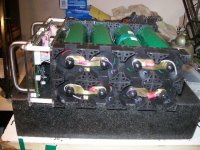ok, day 2...
next day and without having used the pack I charged it again:
View attachment 2-1.png
we can see two things:
-after perfectly balancing the pack and only 24hs of storage, imbalance is enough to raise the voltage of a cell up to 4.0V. clearly this problem A is serious. I don't have a clue why they chose to admit up to 4.1V voltage before triggering the protection.
-because of drift (either of the charger voltage or of the sensing VMS boards or both) the charger is now 40mV * 4 below the target. problem B was not solved by careful trimming because the system has zero tolerance for drift.
so I trimmed the charger again, but instead of bringing it exactly on target, this time I placed it slight above it. this is how it looked like:
View attachment 2-2.png
since the charger is a 3A CCCV, it will source up to 3A to bring the voltage up to it's own target. on the other hand, the VMSes will shunt up to 200mA to lower the voltage to their combined target. there's no question about what will happen: the shunts will operate to maximum capacity and the charger will source enough current to override them and charge the cells too, and will succeed at imposing it's own voltage target.
after reaching equilibrium, the total current will match the current of the least capable shunt. also, all cells will be at or above 3.65V, because if not their shunt would turn off and the cells would charge approximately at 200mA till they reach the threshold. all shunts will be nearly at 100% duty (those cells above 3.65V will be exactly at 100% duty) meaning that bunch control is lost; the individual cells will drift on their own. also, the VMS chain will dissipate its combined absolute maximum power and will remain in this state until the charging is manually stopped. the total voltage imposed by the charger will keep some cells overvolted. really ugly situation...
the VMSes did get hot, and at about minute 14 into the charge I retrimmed the charger live. I placed it just a tiny bit below the target, and left it there up to this day.
to recap on problem B:
1) if the charger voltage is below the VMS chain target:
. a) cell bunches will drift below 3.65V, according to the total voltage constraint.
. b) shunts will be near 0% duty and will only be used to clamp the bunches together.
. c) the charger can potentially detect end of charge.
2) if the charger voltage is above the VMS chain target:
. a) individual cells will drift above 3.65V, according to the total voltage constraint.
. b) for the same charger to VMS voltage difference, individual cells can potentially depart form the 3.65V ideal BY 4 TIMES AS MUCH VOLTAGE compared to case 1); the reason is that in this case cells are allowed to drift on their own instead of in bunches. (but note that resistive shunts will increase their current with increasing cell voltage, so cells will slowly tend to a stable configuration where they'll want to stay. this does not mean they'll be balanced, because the equilibrium state depends on many factors, but rather that it may be improbable that a single cell shoots up too much compared to the others.)
. c) shunts will be near 100% duty and the VMS chain will dissipate its maximum power.
. d) the charger will never see the current go below the shunt current.
3) the charger voltage and/or the VMS voltage sensing will drift around, and (theoretically) it won't be possible to match them.
this holds true for an ideal CCCV charger, but things are better for a real one.
the problem with an ideal CCCV charger is that it will source its maximum current for any voltage below its target, no matter how close to target it is. if the charger has some internal series resistance, or external series resistance is present (in the form of cabling or a fuse for instance), then things change. call this series resistance R. when the load is slowly raising in voltage and causes the transition from CC to CV, the charger will reach target before the load does (due to the voltage drop in R) and current will begin to tapper down from this point onwards. as the load nears the voltage target, the voltage across R will go down, and thus so will the charge current.
this means that when R is introduced, the CC-CV transition will "soften" and the charge current will progressively diminish from max to zero across a voltage range of the load that exists right below the target voltage.
this means that one way to solve problem B is to raise the charger voltage target and introduce a series resistor so that the charge current when all the cells reach the "shunts fully on" target voltage is guaranteed to be in a range manageable by the shunts, no matter how much the relevant voltages are drifting.
VC: charger voltage target (with its tolerance VCtol)
VP: pack (VMS chain) voltage target (with its tolerance)
R: series resistance of the circuit
i: trickle charge current (current when pack is fully charged) (with its tolerance)
i = (VC - VP) / R, so:
imax = (VCmax - VPmin) / R
imin = (VCmin - VPmax) / R
VCmax - VCmin = 2 * VCtol
now say you want a trickle imax of 100mA because you don't want to stress the VMS with too much power dissipation. and say you want an imin of 50mA to compensate for self-discharge and to cover the VMS chain power budget.
now solve the 3 eqs above for VCmax, VCmin and R (the other vars are given), and problem B is history! (make sure you choose an R that can handle the power dissipation imposed by the max charge current of the charger.)
now, some series resistance seems to exist in my setup, because since the last charger trim many days passed and the system has for now always behaved correctly. this is typical:
View attachment 3-1.png
problem A remains. in this case I used an external shunt over the blue cells. I turned off the charger when this shunt started to sink them below 3.65V, because the rest of the cells would be forced above this level (due to the constant total voltage principle). you can see them starting the climb just before the interruption. on the next charge the blue cells lag below, but after resting a bit the third charge shows that they want to lead again.
back to problem B. with the last charger trim, sometimes the cells are just perfect and sometimes a few cells lag below just a tiny bit. you can see this in the red bunch near the middle of the graph. this is as low as I have seen them go for now. it seems that I'm lucky: the series resistance of the system seems JUST ENOUGH to accommodate the voltage tolerances, and so I haven't had the need to add series resistance. but this is extremely dependent on setup, and you may not get this lucky. maybe if I burn the charger output fuse, the next one won't play as nice.
speaking of which, an easy way to add some resistance might be to find a suitable output fuse. different sizes and technologies might give you some range to choose from.
I have the pending assignment of at least measuring the current in this state a couple of times. I guess it is low because sometimes the cells lag, and also because the VMS chain never gets hot. but the resistance of the measurement instrument may completely cloud the results since during the CV phase the circuit is all very low impedance. (think battery and voltage source!)




